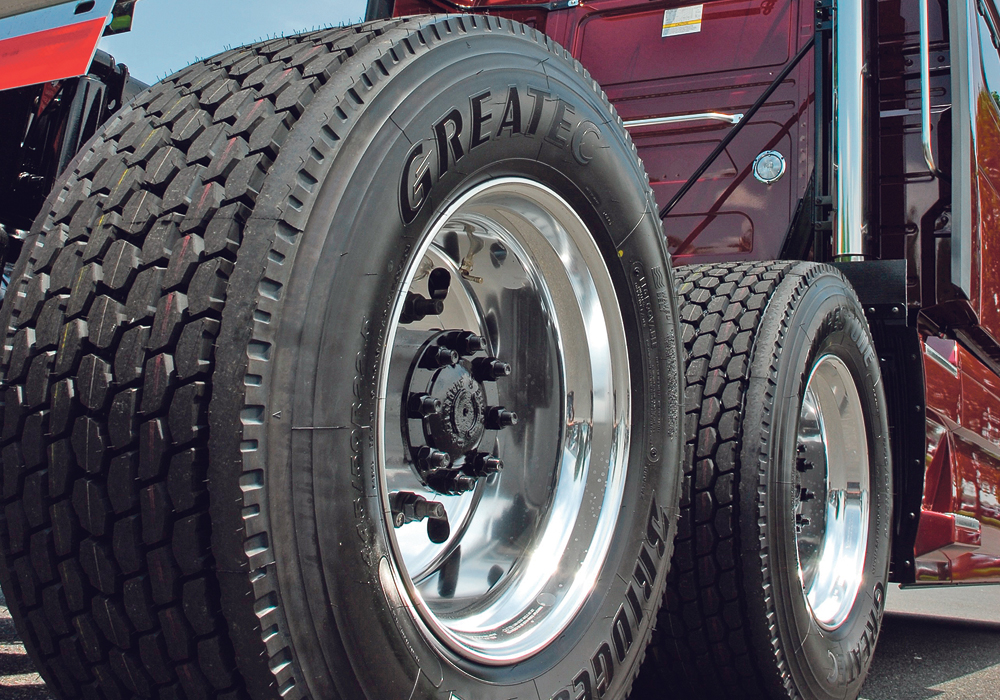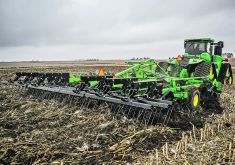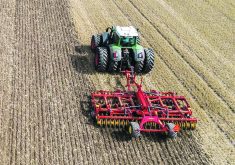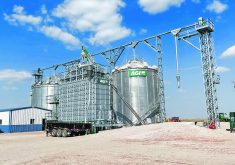Governments establish national uniform weight limits for wide-base single tires, which is good news for trucking industry
Although wide-base super single semi tires are replacing duals in the United States, Canadian truckers and farmers have been reluctant to make the switch because of confusing federal and provincial regulations.
However, there was a breakthrough last month when progress was made in allowing weight parity for the wide super single tires coast to coast. The decision was made during a meeting of the Council of Ministers Responsible for Transportation and Highway Safety.
“Changes to the heavy truck weight and dimension limits for interprovincial operations in Canada pave the way for truckers to use wide-base single tires at the same weight limits as duals right across Canada,” said a news release from the council.
Read Also

Farming Smarter receives financial boost from Alberta government for potato research
Farming Smarter near Lethbridge got a boost to its research equipment, thanks to the Alberta government’s increase in funding for research associations.
“The move brings the weight limit for wide-base singles up to the dual tire limit.”
The decision is good news for the trucking industry. It means a rig with the new-technology tires can legally carry the same GVW as an identical rig on duals. But there’s more. The super singles reduce the weight on each axle. When these two rigs are empty, the one with super singles weighs much less and can therefore carry a bigger payload and earn more money.
The wide tires replace duals and trim about 200 pounds off each axle, freeing up an extra 400 lb. of legal load carrying capacity on the trailer. If they’re also fitted to the tractor, the rig gains nearly 800 lb. of capacity over duals.
However, the numbers vary, depending on which steel rim and which aluminum rim you compare. When aluminum wheels are plugged into the equation, the numbers improve. Comparing super singles on aluminum wheels to duals on steel, Michelin and Bridgestone say the overall weight savings can be as high as 1,300 pounds on the semi. This is a weight reduction that translates directly into payload.
Pierce Fonville of DBL Wheel in Texas builds modular three-piece military style aluminum wheels, which remove even more weight. He said a super single with a capacity of 11,000 lb. weighs 82 lb. when mounted on one of his DBL rims. A comparable steel wheel weighs 150 lb. to have the same capacity.
“Modular wheels are easily assembled and disassembled with an air ratchet,” Fonville said.
“To change a tire, simply remove the outer ring. An additional benefit is the ability to install bead locks so you can air down to 10 lb. per sq. inch to quadruple the contact patch on soft ground.”
Added Paul Gray of OK Tire in Fargo: “Weight saving really is the biggest factor for most farmers. But here in sugar beet country, there’s more to it than just the weight. The trailer pulls a lot easier. I’d say nearly all the sugar beet trailers are on super singles.”
Having seen how they work on his neighbors’ beet haulers, Gray said grain farmers in the Red River Valley have recently started putting them on their hopper bottom trailers, which provides better flotation in the field and eliminates mud between the duals.
“I have one customer at Minto, that’s up near the Manitoba border, and he’s had them on all his hopper trailers for a few years and now he’s installed them on all his drive axles as well. He says it’s working out pretty well for him. Again, it’s a weight thing. He’s gained 800 lb. of capacity on every truck. That’s a lot of extra payload if you’re running your trucks seven days a week.”
Super singles are especially popular with farmers who haul bulk commodities such as liquid, grain, gravel, sugar beets, distillers grain and feed. These types of cargo can be precisely weighed as they are loaded, allowing drivers to load every possible pound of product right up to the legal limit. Wide-base singles have less rotating weight, which translates into better fuel economy. Transport Canada says super singles can reduce fuel consumption by four to six percent.
The regulations regarding tires and vehicle weights are found in the memorandum of understanding signed by the federal and provincial governments, said Geoff Wood, senior vice-president of the Canadian Trucking Alliance. He said the next step is for the provinces and territories to amend their regulations to reflect the changes, and to offer interim permits.
“The outcome of this policy strikes a good balance between road infrastructure preservation and productivity, safety and environmental considerations,” he said.
“It also levels the playing field with respect to Canadian and U.S. fleets in their tire spec’ing options.”


















